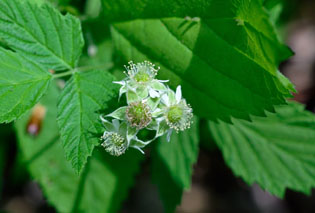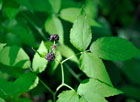BLACK RASPBERRY
|
 |
| File Size: 100 KB |
|
|
|
Rubus occidentalis L.
|
| Konza Prairie, Riley County, Kansas |
| Height: Shrubs, to 10 feet |
| Family: Rosaceae - Rose Family |
| Flowering Period: April, May, June |
|
| Trunks: | | Canes erect or ascending, primocanes and floricanes eventually arched, sometimes rooting at tips, glabrous or sparsely pubescent, glaucous, armed; prickles straight or recurved, .16 to .3 inch; bark reddish purple, smooth, glaucous; wood white, soft. | | Leaves: | | Deciduous, alternate, 3-foliolate or palmately compound; stipules persistent, fused to petiole, .2 to .4 inch; petiole .8 to 2.4 inches, glabrous, usually armed; primocane leaflets 3(-5), lower surface white, canescent to tomentose, upper surface green, glabrous; central leaflet petiolule .2 to 1.4 inches, blade ovate to elliptic, 2.8 to 4.8 inches long, 1.6 to 3.6 inches wide, base rounded to nearly cordate, margins twice-serrate, apex acuminate; lateral leaflets petiolule 0 to .08 inch, blade ovate to ovate-elliptic. | | Flowers: | | Inflorescences axillary or terminal, corymbs, leafy, 3.2 to 14 inches, 2-7(-20)-flowered; peduncles pubescent, usually armed with needle-like and broad-based prickles; pedicels .2 to .28 inch, pubescent, usually armed with needle-like and broad-based prickles. Flowers bisexual, radially symmetric, .3 to .4 inch diam.; hypanthium hemispheric; sepals ovate to elliptic, .2 to .35 inch long, .08 to .12 inch wide; petals 5, white, obovate to elliptic, .08 to .2 inch; pistils numerous on dome-shaped receptacle, ovary superior, 1-locular; style .08 to .12 inch; stigma lobed. | | Fruit: | | June-August; aggregated drupelets, depressed-globose to hemispheric, .5 to .6 inch long and wide, separating as a unit from receptacle; drupelets purplish black, glaucous; stone 1 per drupelet, yellow to tan, compressed-ovoid, ca. .1 inch long. | | Habitat: | | Openings in woodlands, tallgrass and mixed-grass prairies, glades, thickets, pastures, roadsides, fencerows, ditches. | | Distribution: | | East 2/3 of Kansas | | Origin: | | Native | | Uses: | | Native Americans ate the fruit fresh or dried for winter use and steeped the young leaves to make a tea-like beverage. | | Comments: | | Rubus occidentalis is our most common blackberry. It is sometimes cultivated for its fruits, which are eaten raw, made into jams and jellies, or baked in pies and muffins. |
|
| Black raspberry flowers |  | | 77 KB | | Konza Prairie, Riley County, Kansas |
| | Black raspberry leaf |  | | 73 KB | | Morris County, Kansas |
| | Black raspberry leaf undersurface |  | | 76 KB | | Marshall County, Kansas |
| | Black raspberry leaf |  | | 79 KB | | Morris County, Kansas |
| | Black raspberry leaves |  | | 92 KB | | Morris County, Kansas |
| | Black raspberry habit |  | | 184 KB | | Marshall County, Kansas |
| | Black raspberry habit |  | | 160 KB | | Marshall County, Kansas |
| | Black raspberry fruit |  | | 126 KB | | Marshall County, Kansas |
| | Black raspberry fruit |  | | 98 KB | | Marshall County, Kansas |
| | Black raspberry fruit |  | | 203 KB | | Konza Prairie, Riley County, Kansas |
|
|
|
|